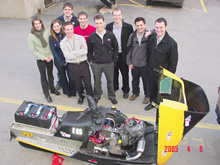Automotive engineers build a cleaner snowmobile

The Concordia students taking part in the Clean Snowmobile Challenge. From the left, Kim Fortin, Caterina Asquino, team captain Robert Huszar, Nick Brodeur (in front of him), Erik Paldy (red shirt), Nicolas Marchand, Todd Lane, Jarid Gurman, and Kevin Jack.
Photo by Jonathan Lussier
The snow is all gone, but that didn’t stop nine mechanical engineering students from starting up their snowmobile behind Reggie’s earlier this month.
The Clean Snowmobile team unveiled the final version of their “hybrid drive snowmobile” on April 6 as a requirement for their capstone project. In order to qualify for anything higher than a B-plus, the students had to demonstrate to program coordinator Henry Hong that the sled actually works.
To the untrained eye, the machine looks like a relic. It is a beat-up 1985 Bombardier 377 Safari the students bought for $300. Although they couldn’t take it for a spin, they raised it up on jacks and stripped the seat and hood to give passers-by a look at what makes this machine different.
The first things that catch the eye are the three large batteries under the seat. These power an electric motor, which in turn assists the traditional internal combustion engine during acceleration. There is a switch that controls the speed of the motor and how and when it engages. The engine runs on E85, which is a potent blend of ethanol and gasoline.
The students were required to choose and execute a capstone project as part of their fourth-year studies.
“There wasn’t too much faith in us at first,” said Erik Paldy, who helped work on the engine. Paldy says they got the idea for the project in September from a competition held each year by the Society of Automotive Engineers (SAE), where students are challenged to build a clean-burning, quiet, comfortable and cost-effective snowmobile. The SAE discourages high-cost solutions, and the Concordia students delivered.
Two teams, one to develop the engine and the other to work on the drive train, were given budgets of $500 each to see the project through. In all, they spent only $800, coming in $200 under budget.
Captain of the drive train team Nick Brodeur says the biggest challenge facing his squad was the shortage of money. With the funds to buy more technology, he says he would have installed a more sophisticated switch and allowed the motor to recharge the three sixty-pound batteries while idling.
So was the machine really green? Yes. They think.
One of the cost compromises the students made was to test the sled’s power on a freshly repaired, untested dynamometer. They were reluctant to rev it up for fear of shaking the apparatus to bits, so showed only a mediocre six horsepower.
Their emissions tests, on the other hand, were more promising. They ran tests with a catalytic converter and without while running the machine on straight gasoline to get an idea of what kind of pollutants they could expect. They replaced the fuel with E85 and ran the same tests. To everyone’s disbelief, the catalyzed E85 tested free of carbon monoxide, a greenhouse gas.
This was Concordia’s first attempt at building a clean snowmobile, but unfortunately this green machine won’t make it to the SAE competition. Many of the vital parts are on loan and by the time you read this story they will have been removed and returned to their rightful owners.
The Concordia chapter of the SAE is extremely active, competing against universities around the world in a variety of design competitions.
Two weeks ago the Aero Design team took their radio-controlled cargo-bearing airplane to competition in Florida. The Formula team designs and fabricates small, formula-style racing cars and they’re currently trying to style a machine based on the mighty F1 racers. The Mini Baja team is dedicated to creating a small off-road vehicle that can compete in punishing races.